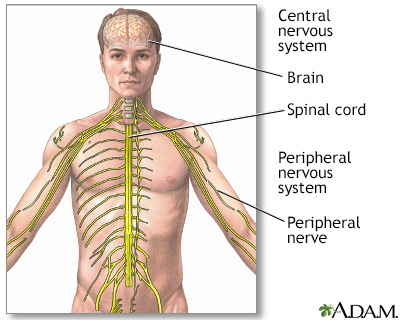Ganglioneuroma
Ganglioneuroma is a tumor of the autonomic nervous system.
Images

I Would Like to Learn About:
Causes
Ganglioneuromas are rare tumors that most often start in autonomic nerve cells. Autonomic nerves manage body functions such as blood pressure, heart rate, sweating, bowel and bladder emptying, and digestion. The tumors are usually noncancerous (benign).
Ganglioneuromas usually occur in people over 10 years of age. They grow slowly, and may release certain chemicals or hormones.
There are no known risk factors. However, the tumors may be associated with some genetic problems, such as neurofibromatosis type 1.
Symptoms
A ganglioneuroma usually causes no symptoms. The tumor is only discovered when a person is examined or treated for another condition.
Symptoms depend on the location of the tumor and the type of chemicals it releases.
If the tumor is in the chest area (mediastinum), symptoms may include:
- Breathing difficulty
- Chest pain
- Compression of the windpipe (trachea)
If the tumor is lower down in the abdomen in the area called the retroperitoneal space, symptoms may include:
- Abdominal or back pain
- Bloating
If the tumor is near the spinal cord, it may cause:
- Compression of the spinal cord, which leads to pain and loss of strength or feeling in the legs, arms, or both
- Spine deformity
These tumors may produce certain hormones, which can cause the following symptoms:
- Diarrhea
- High blood pressure
- Increased body hair
Exams and Tests
The best tests to identify a ganglioneuroma are:
- CT scan of the chest, abdomen, and pelvis
- MRI scan of the chest and abdomen
- Ultrasound of the abdomen or pelvis
Blood and urine tests may be done to determine if the tumor is producing hormones or other chemicals.
A biopsy or complete removal of the tumor may be needed to confirm the diagnosis.
Treatment
Treatment involves surgery to remove the tumor (if it is causing symptoms).
Outlook (Prognosis)
Most ganglioneuromas are noncancerous. The expected outcome is usually good.
Possible Complications
If the tumor has been present for a long time and has pressed on the spinal cord or caused other symptoms, surgery to remove the tumor may not reverse the damage. Compression of the spinal cord may result in loss of movement (paralysis), especially if the cause is not detected promptly.
Surgery to remove the tumor may also lead to complications in some cases. In rare cases, problems due to compression may occur even after the tumor is removed.
When to Contact a Medical Professional
Contact your health care provider if you or your child has symptoms that may be caused by this type of tumor.
References
Goldblum JR, Folpe AL, Weiss SW. Benign tumors of peripheral nerves. In: Goldblum JR, Folpe AL, Weiss SW, eds. Enzinger and Weiss's Soft Tissue Tumors. 7th ed. Philadelphia, PA: Elsevier; 2020:chap 26.
Kaidar-Person O, Zagar T, Haithcock BE, Weiss J. Diseases of the pleura and mediastinum. In: Niederhuber JE, Armitage JO, Kastan MB, Doroshow JH, Tepper JE, eds. Abeloff's Clinical Oncology. 6th ed. Philadelphia, PA: Elsevier; 2020:chap 70.
Kutikov A, Crispen PL, Uzzo RG. Pathophysiology, evaluation, and medical management of adrenal disorders. In: Partin AW, Dmochowski RR, Kavoussi LR, Peters CA, eds. Campbell-Walsh-Wein Urology. 12th ed. Philadelphia, PA: Elsevier; 2021:chap 106.
BACK TO TOPReview Date: 8/19/2024
Reviewed By: Joseph V. Campellone, MD, Department of Neurology, Cooper Medical School at Rowan University, Camden, NJ. Review provided by VeriMed Healthcare Network. Also reviewed by David C. Dugdale, MD, Medical Director, Brenda Conaway, Editorial Director, and the A.D.A.M. Editorial team.

Health Content Provider
06/01/2025
|
A.D.A.M., Inc. is accredited by URAC, for Health Content Provider (www.urac.org). URAC's accreditation program is an independent audit to verify that A.D.A.M. follows rigorous standards of quality and accountability. A.D.A.M. is among the first to achieve this important distinction for online health information and services. Learn more about A.D.A.M.'s editorial policy, editorial process and privacy policy. A.D.A.M. is also a founding member of Hi-Ethics. This site complied with the HONcode standard for trustworthy health information from 1995 to 2022, after which HON (Health On the Net, a not-for-profit organization that promoted transparent and reliable health information online) was discontinued. |
The information provided herein should not be used during any medical emergency or for the diagnosis or treatment of any medical condition. A licensed medical professional should be consulted for diagnosis and treatment of any and all medical conditions. Links to other sites are provided for information only -- they do not constitute endorsements of those other sites. © 1997- 2025 A.D.A.M., a business unit of Ebix, Inc. Any duplication or distribution of the information contained herein is strictly prohibited.
